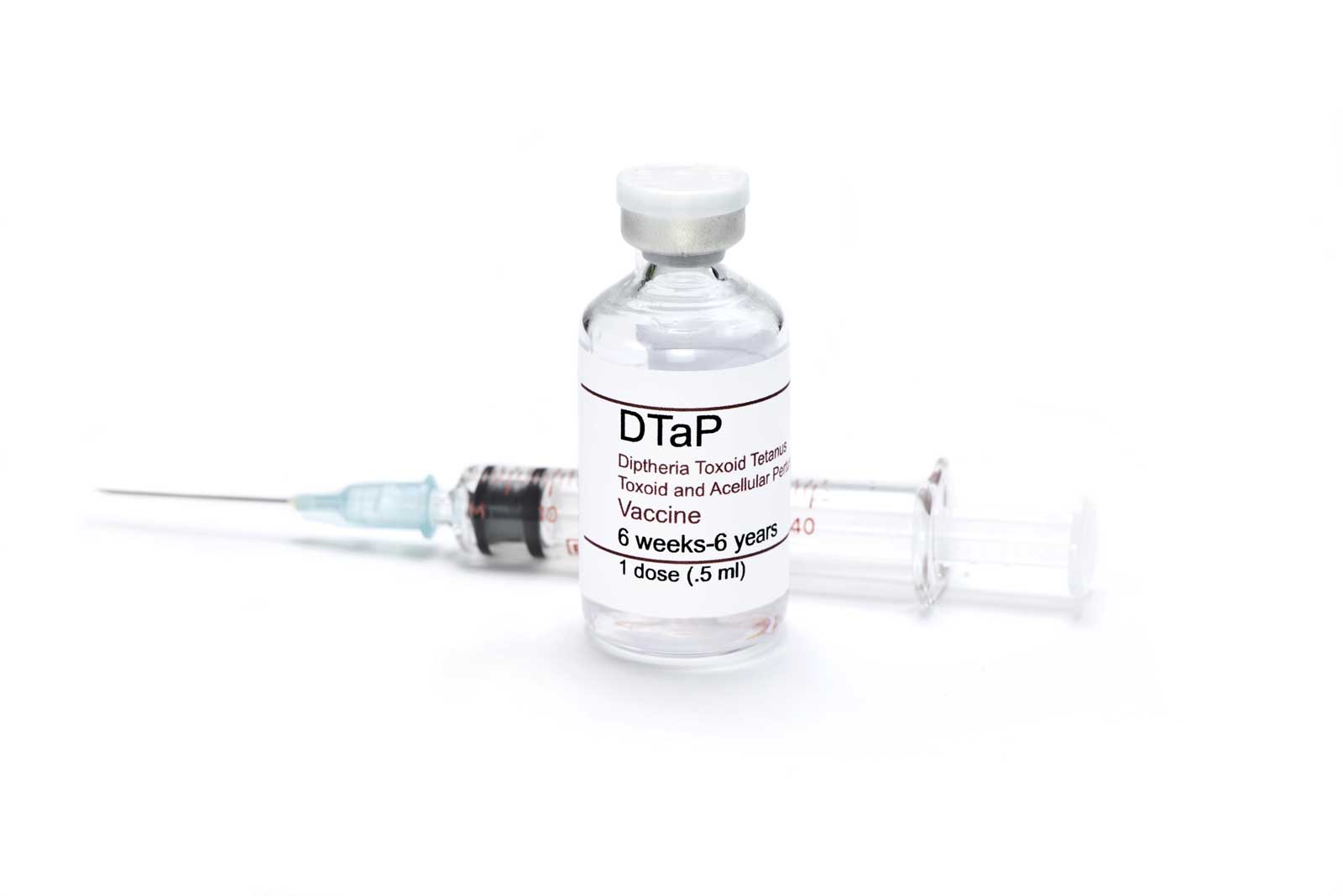Summary:
- Diphtheria is deadly and still common in many parts of the world, including some cases in the United States.
- Tetanus lives in the soil and anyone who is not immunized is at risk.
- Pertussis is still quite common and is a serious or deadly disease in infants especially. Many cases are still seen in the United States.
- The vaccine has no serious side effects and the risks of the diseases outweigh the risk of the vaccine.
- HIGHLY RECOMMENDED
The DTaP vaccine is a combination vaccine, immunizing against more than one disease in the same injection (therefore reducing the number if injections needed), though we don’t tend to think of it as a combination vaccine because it has been around so long. The DTaP vaccine stands for and protects against three diseases: diphtheria, tetanus (lockjaw), and pertussis (whooping cough). The “a” in the name stands for acellular pertussis, which is a modification made in 1991 to the older DTP vaccine. As a result, it has far fewer side effects. Pertussis is still very common, mostly among teenagers and young adults. Babies are at high risk of catching it and becoming very ill or dying from it. I have cared for numerous children in the hospital with it, I still see it in my office in unimmunized children and in teenagers, and have friends whose baby almost died from it. There are still diphtheria outbreaks overseas, with occasional cases in the U.S., and tetanus lives in the soil and will never go away. But pertussis is the greatest risk, and the benefits of the vaccine outweigh the risk for babies.
The Diseases
Diphtheria is a severe bacterial infection caused by Corynebacterium diphtheriae. It infects the nose and throat; the disease is actually caused by a toxin that the bacteria produce. The infection is spread easily from person to person. The infection may make it hard to breathe and swallow, but more importantly the toxin also attacks the heart, kidneys, and nerves causing paralysis, heart failure, and death. In the 1920’s in the United States, about 150,000 people a year got diphtheria and about 15,000 of them died. The disease has almost disappeared since the introduction of the vaccine in the early 1940’s; however, outbreaks still occur when immunization rates fall. There were several severe outbreaks in Eastern Europe and Russia in the 1990’s, with over 150,000 cases from 1990-1996, with up to a quarter (23%) fatality rate. Many infections were carried to other countries.
Interestingly, the vaccine works by making the immune system attack and inactivate the toxin produced by the bacteria; it does not make the body attack the germ itself! Booster doses are needed to maintain immunity in adolescents and adults (with the tetanus booster). The disease is still common in many parts of the world and has been imported to the United States. It also causes skin infections in the United States, which can then spread to cause much more serious throat infections.
Tetanus is a lethal infection caused by a common bacteria that lives in the soil, Clostridium tetani. People catch tetanus not from other people but through a break in the skin (cuts, scratches, puncture wounds, bites, burns) that is contaminated with dirt containing the spores of the bacteria. Once inside the body, the bacteria produce a lethal toxin that paralyzes muscles, including the jaw (thus the term “lockjaw’); it also paralyzes the chest muscles, making it impossible to breathe, and the heart, leading to death without mechanical support. It causes muscle spasms and contractions so strong and violent that it can break the bones of children. Young children and the elderly are most susceptible to the disease. Since the bacteria live in the soil, tetanus continues to be a threat and cannot be eradicated. Teenagers and adults need a booster shot (Td or Tdap) every 10 years to remain protected. The vaccine works by making the immune system attack and inactivate the toxin produced by the bacteria. The vaccine was first produced in the 1920’s and became a routinely used in children in the 1940’s. At that time, there were about 500 cases of tetanus a year; this has dropped to around 50 now, and about 30% of people who get tetanus die from it.
Pertussis, or whooping cough, is a common disease even today. It is a highly contagious disease caused by the bacterium Bordetella pertussis. It causes a severe cough that can cause difficulty breathing and seizures; it can also cause pneumonia. It can lead to brain damage, mental retardation, and death. Before the vaccine there were between 150,000 and 250,000 cases a year, with 8,000 to 9,000 deaths. Now there are about 10 children who die from pertussis a year. However, the vaccine does not produce lifelong immunity, and there are currently about 600,000 to 900,000 cases a year in adolescents and adults, in whom the disease is not life-threatening. Infants can easily catch pertussis from a teenager or adult with the disease; when I was working in children’s hospitals, I cared for several children a year with pertussis. I still occasionally see it in my outpatient practice as well. I also have friends whose baby almost died from pertussis (the baby was too young to have received the immunization). It is therefore very important that babies continue to get this vaccine. Also, in 2005, we started giving teenagers a booster shot against pertussis, along with the tetanus shot they already receive. The Tdap vaccine is also recommended for adults who have never had a booster pertussis vaccine, and for pregnant women during every pregnancy.
The Vaccine
Diphtheria vaccine is made by altering the toxin produced by the bacteria, inducing the immune system to develop antibodies that inactivate the toxin, which is what causes disease in humans. The tetanus vaccine is made the same way.
The original vaccine was developed in the 1930’s and widely used starting in the 1940’s.
The pertussis vaccine used to be made by killing and injecting the whole bacteria, thus the term whole cell vaccine. It caused a lot of side effects, including high fever, inconsolable crying, and sometimes seizures, probably from the fever (which were not harmful but were certainly frightening and unpleasant!). There were also reports of more severe side effects but these were never linked to the vaccine. A new form of the vaccine, the acellular form, has been in use since 1991 for the 4th and 5th doses and since 1996 for the entire series. Like most other vaccines, it consists of specific proteins or antigens from the bacterium, not the whole organism. The side effects are at least 10-fold less than the old vaccine. Most children have few if any side effects at all. There is no way to catch any disease or illness from the vaccine.
Schedule
The DTaP vaccine is given at ages 2, 4, and 6 months, and at 15-18 months; a booster is given between ages 4 and 6 years. A total of five doses are given (unless the 4th dose is given after the child turns 4 years old; then a 5th dose is not necessary). A booster tetanus and diphtheria shot (Td) is needed every 10 years for the rest of a person’s life; the first one is usually given at age 11-12 years. This booster also include a pertussis booster as well. (Tdap). Adults who have never received a pertussis booster (Tdap) need one dose. In addition, parents, siblings and caregivers of newborn babies need to have received one or get one if they have not, and pregnant women should receive one during each pregnancy.
How it is given
The vaccine is injected into the thigh or arm muscle, either alone or as part of another combination vaccine (see below). It is safe and effective to give DTaP along with other vaccines the same day, and it is safe and effective to give multiple injections in the same arm or leg.
Side effects
The vaccine causes several common side effects such as tenderness, pain, redness, or swelling at the injection site in about 1/3 of children. This reaction is more likely in older children after the 4th or 5th dose. It usually occurs within 1-2 days of the shot. Occasionally, the entire arm or leg will swell for several days; this will resolve with no long-term effects. About 5% of children will get a fever 101 or higher for a day or two. Many children will eat a little less and either be a little cranky or a little drowsy for a day or two.
Rarely, a child may have a fever 104 or higher (which is not harmful). Some babies may cry for several hours after the shot. Very rarely, a baby may become pale and limp for a short while, or may have a seizure. The seizure is likely a febrile seizure due to the fever itself and is not related to the immunization. These reactions were sometimes seen with the DTP vaccine, but are hardly ever seen since the introduction of the acellular pertussis vaccine.
Extremely rarely (1 in a million doses), an allergic reaction can occur causing hives and difficulty breathing, which can be treated with medications. The reaction usually occurs 15-30 minutes after the shot.
Risks vs. benefits
The risks of the vaccine are small, with the side effects noted above, and no one has ever died from the vaccine. On the other hand, the risks of the diseases are still quite high, especially for pertussis. Diphtheria outbreaks are occurring in other countries when immunization rates fall, and tetanus is a continual possibility since it comes from bacteria living in the soil. Pertussis is widespread in teenagers and young adults, and is still causing serious illness and death in infants, even today with all the medical advances in supportive care for ill children. For these reasons, the benefits of the vaccine far outweigh the risks; to put it another way, the risks of the diseases far outweigh the risks of the vaccine.
Contraindications & Precautions
Someone who has had a severe allergic reaction to DTaP vaccine should not get another dose. A child who is moderately or severely ill should probably delay the vaccination until he or she has recovered from the illness. A child who has had any of the following reactions after DTaP should probably not receive another pertussis-containing vaccine (and should receive DT instead): encephalopathy (brain illness) within 7 days after a dose; a fever of 105 within 48 hours after a dose; a collapse or a shock-like state within 48 hours after a dose; crying continuously for 3 or more hours within 48 hours of a dose; seizures (convulsions) within 3 days of a dose. Note that these reactions are extremely rare with DTaP and were more common with the DTP vaccine (though rare then as well).
Combination vaccines
The DTaP vaccine (which is itself a combination vaccine), is included in several combination vaccines in use in the United States (and in many more in other countries). In the US, these include Pediarix™ (DTaP-HepB-IPV), Pentacel™ (DTaP-HIB-IPV), TriHIBit™ (DTaP-HIB), and Kinrix™ (DTaP-IPV).
Related vaccines
Tdap
This is a tetanus booster with added pertussis booster vaccine. It has replaced Td as the booster shot given to teenagers. Adults who have never had a pertussis booster need one dose as well, especially if caring for a newborn infant. Pregnant women should receive one during each pregnancy.
Td
This is the routine tetanus booster shot given to adults (and formerly given to teenagers before it was replaced by the Tdap vaccine). Everyone needs one every 10 years. Teenagers, and any adult who has not had one, should get one booster of Tdap instead, then resume Td shots every 10 years. It is mainly to prevent tetanus infection, though it does provide some diphtheria immunity. It is also used in children 7 and up who need tetanus and/or diphtheria vaccination without pertussis vaccine.
DT
This is a diphtheria and tetanus vaccine used in children less than7 years old who need vaccination but for some reason need to avoid pertussis vaccine. It is not commonly used.
My Recommendations
Given the fact that pertussis is still common (I still see it in my office), it still harms and kills babies despite the best medical care, and the vaccine has no known serious side effects or risks, I highly recommend this vaccine. I think it should be given as early as possible, which is at 2 months of age. Diphtheria is still common overseas and can travel to this country, and tetanus lives in the soil and will always be a risk, especially to infants and the elderly. Both of these disease are serious and often fatal. The benefits of this vaccine far outweigh any possible risks.
Resources
DtaP Vaccine Information Statement (VIS) from the CDC
References
Use of DTaP (Diphtheria Toxoid-Tetanus Toxoid-Acellular Pertussis) Vaccine as a Five-Dose Series MMWR, November 17, 2000, Vol 49, #RR-13
Last revised May 10, 2016. Published June 13, 2005.



